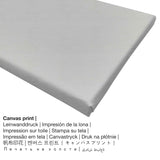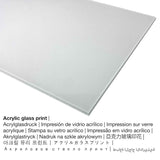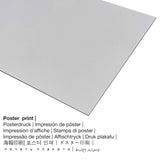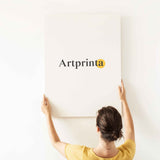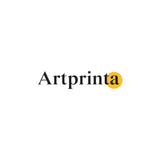Vincent van Gogh, 1890 - Pola w Auvers - druk artystyczny
Podatek jest wliczony. Koszt wysyłki zostanie obliczony W kasie.
Interesujące fakty na temat tego ponad 130-letniego obrazu
Dzieło sztuki współczesnej zostało namalowane przez artystę Vincent van Gogh in 1890. The artpiece was painted with the size: 50 × 101 cm - frame dimensions: 67 x 118 x 8 cm vitrified and was manufactured with the technika of oil on canvas. What is more, the work of art is in the the Belvedere's art collection in Wiedeń, Austria. Dzięki uprzejmości: © Belvedere, Wiedeń, numer inwentarzowy: 1007 (licencja - domena publiczna). : poświęcenie Secesji, Wiedeń w 1909 roku. Ponadto wyrównanie jest w porządku krajobraz format with a side ratio of 2 : 1, which implies that the length is two times longer than the width. The painter, botanical illustrator, printmaker, drawer Vincent van Gogh was a European artist, whose style can mainly be attributed to Post-Impressionism. The Dutch painter was born in the year 1853 w Zundert w Brabancji Północnej w Holandii i zmarł w wieku 37 w 1890 roku.
Wybierz wybrany materiał przedmiotu
In the dropdown lists next to the article you can select your prefered size and material. We allow yout to choose among the following variants:
- Nadruk metalowy (dibond aluminiowy): This is a metal print made on aluminium dibond material with an outstanding depth effect. A direct Direct Print on Aluminum Dibond is your excellent start to fine replicas with aluminum. For your Direct Aluminium Dibond print, we print your selected artpiece onto the aluminium composite white-primed surface.
- Drukowany plakat (materiał płócienny): A poster print is a printed canvas paper with a slight surface finish, which reminds the original version of the masterpiece. Please keep in mind, that depending on the size of the canvas poster print we add a white margin of approximately 2-6 cm round about the painting in order to facilitate the framing.
- Wydruk na płótnie: A canvas print, not to be mistaken with a painting on a canvas, is an image applied directly on canvas material. A canvas has the sculptural impression of three-dimensionality. How can I hang a canvas on my wall? The advantage of canvas prints is that they are relatively low in weight, meaning that it is easy and straightforward to hang the Canvas print without the help of additional wall-mounts. Canvas prints are suited for any kind of wall.
- Wydruk na szkle akrylowym (z powłoką z prawdziwego szkła): A glossy print on acrylic glass, which is sometimes denoted as a print on plexiglass, will turn your selected original artwork into brilliant décor and forms a distinct alternative to dibond or canvas art prints. Your favorite artwork is custom-made with the help of state-of-the-art UV printing machines.
Ważna informacja: We try to depict our art products with as many details as possible and to illustrate them visually. Nonetheless, the tone of the printing material and the imprint might diverge marginally from the image on the monitor. Depending on your screen settings and the condition of the surface, color pigments can unfortunately not be printed as exactly as the digital version on this website. Because all our fine art prints are printed and processed manually, there may also be minor deviations in the size and exact position of the motif.
O produkcie
| Produkt do druku: | Wall Art |
| Reprodukcja: | reprodukcja w formacie cyfrowym |
| Proces produkcji: | Bezpośredni nadruk UV |
| Produkcja: | Produkcja niemiecka |
| Rodzaj akcji: | produkcja na żądanie |
| Przeznaczenie: | galeria grafiki artystycznej, dekoracja ścienna |
| Orientacja: | wyrównanie krajobrazu |
| Współczynnik proporcji obrazu: | 2 : 1 długość do szerokości |
| Implikacja: | długość jest dwa razy większa niż szerokość |
| Dostępne tkaniny produktu: | wydruk na metalu (dibond aluminium), wydruk na szkle akrylowym (z powłoką z prawdziwego szkła), wydruk plakatu (papier płócienny), wydruk na płótnie |
| Płótno na krośnie (wydruk na płótnie) warianty rozmiarów: | 40x20cm - 16x8", 60x30cm - 24x12", 80x40cm - 31x16", 100x50cm - 39x20", 120x60cm - 47x24", 160x80cm - 63x31", 180x90cm - 71x35" |
| Obraz na szkle akrylowym (z powłoką z prawdziwego szkła): | 40x20cm - 16x8", 60x30cm - 24x12", 80x40cm - 31x16", 100x50cm - 39x20", 120x60cm - 47x24" |
| Opcje druku plakatu (papier płócienny): | 60x30cm - 24x12", 80x40cm - 31x16", 100x50cm - 39x20", 120x60cm - 47x24" |
| Warianty wielkości wydruku z dibondu aluminium: | 40x20cm - 16x8", 60x30cm - 24x12", 80x40cm - 31x16", 100x50cm - 39x20", 120x60cm - 47x24" |
| Ramka: | nieoprawiona kopia sztuki |
Podstawowe dane dotyczące unikatowego dzieła sztuki
| Nazwa dzieła sztuki: | "Fields in Auvers" |
| Klasyfikacja dzieła: | malarstwo |
| Szeroka kategoria: | sztuka współczesna |
| Klasyfikacja czasowa: | 19th wieku |
| Rok powstania: | 1890 |
| Przybliżony wiek dzieł sztuki: | 130 lat |
| Oryginalny nośnik grafiki: | olej na płótnie |
| Wymiary oryginalnego dzieła sztuki: | 50 × 101 cm - frame dimensions: 67 x 118 x 8 cm vitrified |
| Muzeum / lokalizacja: | Belweder |
| lokalizacja muzeum: | Wiedeń, Austria |
| strona internetowa muzeum: | www.belvedere.at |
| Rodzaj licencji: | domena publiczna |
| Dzięki uprzejmości: | © Belvedere, Wiedeń, nr inwentarzowy: 1007 |
| Linia kredytowa grafiki: | poświęcenie Secesji, Wiedeń w 1909 roku |
Podstawowe informacje o artyście
| Artysta: | Vincent van Gogh |
| Znany również jako: | j. van gogh, Gogh, van Gogh Vincent, ゴッホ, Gogh Vincent-Willem van, Fan-ku, Fangu, Fan'gao, Gogh Vincent Willem van, Fangu Wensheng, van gogh, Van-Gog Vint︠s︡ent, Vincent van Gogh, ビンセントゴッホ, Gogh Vincent van, גוג וינסנט ואן, גוך וינסנט ואן, Fan-kao, 梵高, v. van gogh |
| Płeć artysty: | zły |
| Narodowość: | holenderski |
| Praca artysty: | rysownik, ilustrator botaniczny, malarz, grafik |
| Kraj artysty: | Holandia |
| Kategoria artysty: | współczesny artysta |
| Style sztuki: | Postimpresjonizm |
| Zmarł w wieku: | 37 roku |
| Rok urodzenia: | 1853 |
| Miejsce urodzenia: | Zundert, Brabancja Północna, Holandia |
| Zmarł w roku: | 1890 |
| Zmarł w (miejsce): | Auvers-sur-Oise, Ile-de-France, Francja |
© Prawa autorskie - www.artprinta.com (Artprinta)
Original artwork specifications as provided by Belvedere (© Copyright — Belvedere — Belweder)
The "Plain of Auvers" is one of the twelve works that form a cycle of rural life and were color coordinated by Van Gogh. So he wrote to his brother Theo that "this extremely makes good next to another in widescreen format, in addition to 'wheat fields' - because the image is a portrait and pink, the other pale green and yellow green, complementary colors to pink." Impressively the picture is the large expanse of the landscape. It acts as reduced to a few large-seen forms that identify the characteristics of the area. The blue-green sky does not convey the glow of a clear day, but rather the mood after the rain or on a cloudy day. The strong low flight, the highly-term horizon and the space gained by overlapping convey the simplest means an impression of the hilly country around Auvers. In addition, the color perspective of always uniform blue green expectant tones against the horizon, while the foreground the bright colors full of freshness and increase in its rich diversity of each other. The image - a masterpiece of the artist - appears more subtle in the invoice as well as in color and more refined than many other paintings of the last few weeks Van Gogh. [Stephan Koja, in: Austrian Gallery Belvedere Vienna, Prestel museum guide, Munich et al 2001] The image was acquired in 1903 as part of the Impressionist exhibition of Secession by some members and supporters of the artists' association for the purpose of dedication to the Modern Gallery, but initially remained at the Secession and not get into the few months later opened Permanent Collection of Modern Gallery in the Lower Belvedere. The Secession had initially postponed the dedication because of yet unknown conditions of the new museum. Only an inquiry Gustav Klimt to the Ministry of Culture and Education with a request for loan from the International Art Show in 1909, which was answered in the negative because the picture still was not in state ownership, gave the dedication rolling again. That same year, the picture was inventoried in the existence of the Modern Gallery. [Markus Fellinger, 09/2019]


